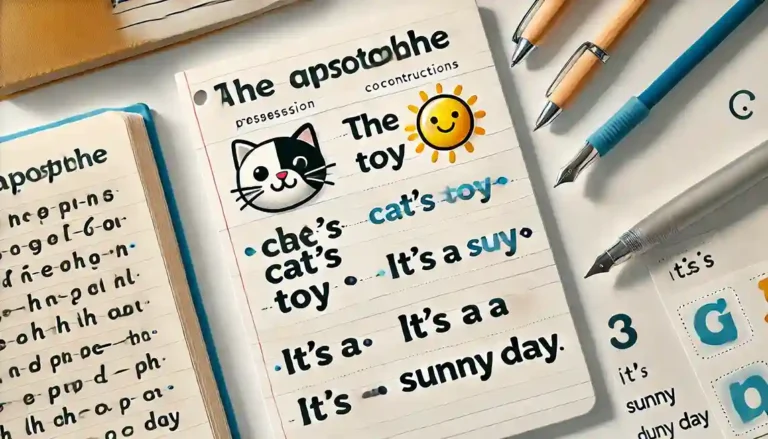The ápostrophe may be small, but it plays a huge role in the English language. It’s one of those punctuation marks that people often misuse, even though its rules are pretty straightforward. Whether you’re writing a casual email or crafting a formal report, knowing how to use an apostrophe can make a big difference in how polished your writing looks.
In this blog post, we’ll dive into what the apostrophe is, when and how to use it, and some common mistakes to avoid. By the end of this, you’ll be an apostrophe pro!
What Is an Apostrophe?
An apostrophe (’) is a punctuation mark used primarily in two ways: to indicate possession and to form contractions. It can also be used in rare cases to show the omission of letters or numbers, like in old-fashioned writing or slang.
Understanding how to use an apostrophe correctly is crucial because misuse can change the meaning of a sentence and confuse your reader. It’s a small mark with a lot of power!
The Two Main Uses of the Apostrophe
Let’s break down the two most common uses of the apostrophe:
1. Showing Possession
The apostrophe is commonly used to show ownership. When you want to indicate that something belongs to someone or something, you use an apostrophe followed by the letter “s.”
- Singular nouns: To show possession for singular nouns, simply add an apostrophe + “s.”
- Example: The cat’s toy (The toy belongs to the cat.)
- Plural nouns: If a noun is plural and ends in “s,” just add the apostrophe after the “s.”
- Example: The students’ books (The books belong to the students.)
- Irregular plural nouns: For plural nouns that don’t end in “s,” add apostrophe + “s.”
- Example: The children’s playground (The playground belongs to the children.)
2. Forming Contractions
Apostrophes are used to combine words by shortening them. This is what we call a contraction.
- Common examples:
- Don’t = do not
- It’s = it is
- We’re = we are
Using contractions makes writing more conversational and casual, which is why you’ll often see them in informal settings like text messages or casual blogs (like this one!).
Common Mistakes with Apostrophes
Despite its simple rules, the apostrophe is often misused. Here are some common mistakes to watch out for:
1. Using Apostrophes in Plurals
One of the most common mistakes is using an apostrophe to make a word plural, which is incorrect. Apostrophes are not used to form plurals.
- Incorrect: The dog’s are barking.
- Correct: The dogs are barking.
2. Its vs. It’s
This is a common source of confusion. It’s (with an apostrophe) is the contraction for “it is” or “it has.” Its (without an apostrophe) shows possession, meaning “belonging to it.”
- Example:
- It’s raining outside. (It is raining.)
- The dog wagged its tail. (The tail belongs to the dog.)
3. Apostrophes with Decades or Years
When writing about decades or years, people sometimes mistakenly use an apostrophe before the “s.”
- Incorrect: The 1990’s were great!
- Correct: The 1990s were great!
If you’re omitting part of the year, that’s when you use the apostrophe.
- Example: I was born in ’95. (instead of 1995)
Tips to Remember About Apostrophes
If you’re still unsure when to use an apostrophe, here are a few tips to help you remember:
- Always ask yourself: Is there possession or a contraction in this sentence? If not, you probably don’t need an apostrophe.
- For its/it’s, remember that if you can replace the word with “it is” and the sentence still makes sense, you need the apostrophe.
- Avoid using apostrophes to form plurals, even for numbers or acronyms.
Conclusion
The ápostrophe might be small, but it’s mighty! When used correctly, it adds clarity and precision to your writing. Whether you’re indicating possession or forming contractions, following these simple rules will ensure you avoid common apostrophe mistakes. So the next time you write, you can feel confident that you’re using this tiny punctuation mark the right way.
FAQs
Q: Can I use an apostrophe to make a word plural?
A: No, apostrophes are not used to make words plural. Plurals are formed by adding “s” or “es” without an apostrophe.
Q: What’s the difference between “its” and “it’s”?
A: “It’s” is a contraction for “it is” or “it has,” while “its” is a possessive pronoun that means “belonging to it.”
Q: How do I show possession for a plural noun?
A: For plural nouns ending in “s,” simply add the apostrophe after the “s” (e.g., students’). For irregular plurals, add apostrophe + “s” (e.g., children’s).
Q: When do I use an apostrophe for years or decades?
A: You don’t need an apostrophe for decades (e.g., 1990s). Use an apostrophe only if you’re shortening the year (e.g., ’95 for 1995).

